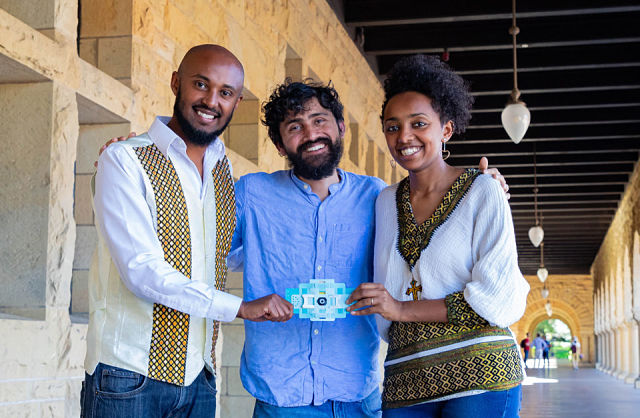 This past summer, engineering graduate students Loza Tadesse and Tim Abate returned to their home country of Ethiopia to teach local college students about science research and educational opportunities. (Photo: Abate, professor Manu Prakash of the Stanford Bioengineering Department, and Tadesse with a foldscope, a $1 microscope developed by Prakash and other Stanford scientists/Image credit: Trever Tachis)
This past summer, engineering graduate students Loza Tadesse and Tim Abate returned to their home country of Ethiopia to teach local college students about science research and educational opportunities. (Photo: Abate, professor Manu Prakash of the Stanford Bioengineering Department, and Tadesse with a foldscope, a $1 microscope developed by Prakash and other Stanford scientists/Image credit: Trever Tachis)
Loza Tadesse and Iwnetim “Tim” Abate may have left their home country of Ethiopia to pursue engineering studies, but they haven’t forgotten their roots. The Stanford engineering PhD students returned home this past summer to share their expertise with college students and expose them to science research and education.
Tadesse and Abate convened a team of 13 scientists and graduate students from Stanford, the University of California, Berkeley, Pepperdine University, the University of Chicago, the University of Akron and the University of Toronto. Together, they traveled to Ethiopia’s capital, Addis Ababa, to lead a five-day summer school for some of Ethiopia’s most promising undergraduates in STEM fields. The program was organized in partnership with the Ethiopian Physical Society in North America, where Tadesse and Abate are executive committee members.
“Our goal was to motivate college students back home to pursue higher education – Master of Science degrees and PhDs – and research,” Abate said. “Our summer program was focused on teaching them about the current trends in different fields, how to apply to graduate school, how to apply to internships and find research opportunities.”
Abate and Tadesse reached out to local universities to recruit their best students in STEM fields for the summer school, which was hosted at Addis Ababa University, Addis Ababa Science and Technology University and the University of Gondar. They sought 40 students for the program, but due to the amount of interest, they ended up with 50.
Science as accessible
Each day of the program, students attended classes in science and engineering disciplines – physics; computer science; materials; biological, mechanical and chemical engineering – that were related to the research conducted by the instructors. For instance, Tadesse, a PhD candidate in bioengineering, taught classes related to her Stanford research on improving medical devices for infection diagnostics and bio-inspired engineering design, while Abate, a PhD candidate in materials science and engineering, taught classes about his research on improving lithium ion batteries.
—
Join the conversation on Twitter and Facebook

























